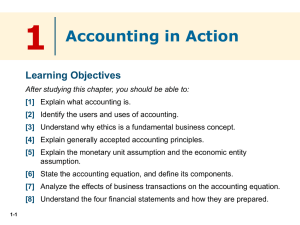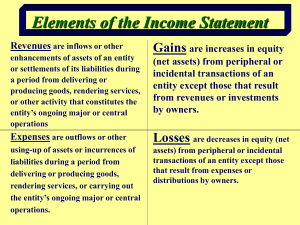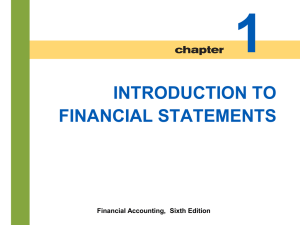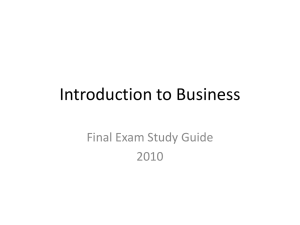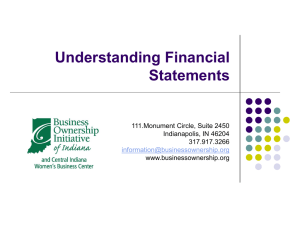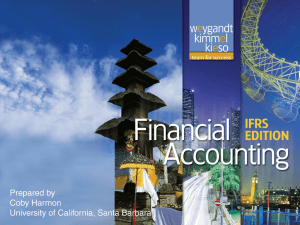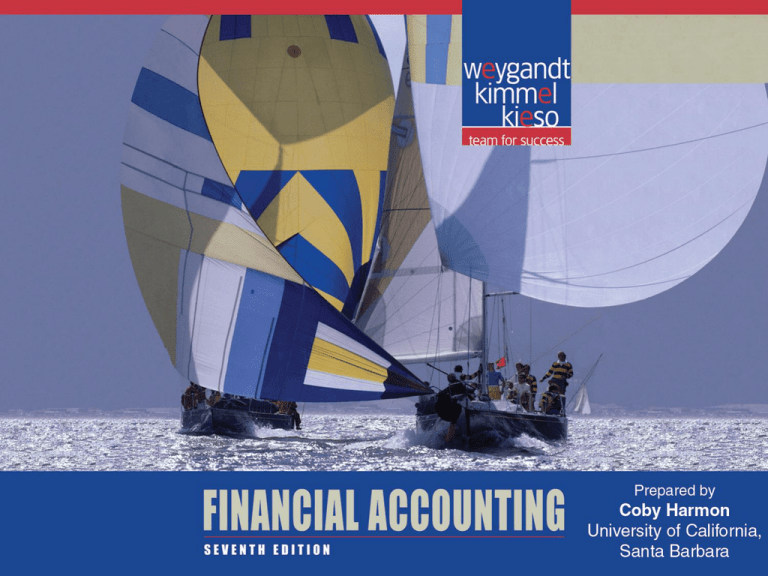
Slide
1-1
Accounting in
Action
Accounting 201, Instructor: Judith Paquette
Financial Accounting, Seventh Edition
Slide
1-2
Two Important Statements
INCOME STATEMENT
BALANCE SHEET
Slide
1-3
Revenue
Expenses
Net Income or Net Loss
Assets
Liabilities
Stockholders’ Equity (can be negative, more on
this later)
Revenues
The Amount Earned from Sales or
Services
During the time period described at
the top of the Income Statement
Slide
1-4
Expenses
The Costs incurred to generate
Revenues
During the time period described at
the top of the Income Statement
Slide
1-5
The Bottom Line
If Revenues Exceed Expenses in the
current period, it’s called “Net Income”
If Expenses Exceed Revenues in the
current period, it’s called “Net Loss”
Slide
1-6
Financial Statements
Income Statement
Reports the revenues and expenses for a specific period of time.
Net income – revenues exceed expenses.
Illustration 1-10
Financial statements and
Net loss – expenses exceed revenues.
their interrelationships
Slide
1-7
SO 8 Understand the four financial statements and how they are prepared.
Assets
Things
of Value, resources
Owned by the Company
As a result of past transactions
Will be used to generate future
revenues
Slide
1-8
Liabilities
Amounts
the business owes to creditors
Claims against the Assets
Slide
1-9
Owners’ Equity
What is owned, “free and clear” of debt
by the company’s owners
Who are the owners?
Residual claim against the Assets
After the creditors’ claims have been
satisfied
Assets - Liabilities = Owners’ Equity
Also
Slide
1-10
called Net Worth
Financial Statements
Balance Sheet
Illustration 1-10
Financial statements and
their interrelationships
Slide
1-11
SO 8 Understand the four financial statements and how they are prepared.
Identify the elements
Slide
1-12
Study Objectives
Slide
1-13
Define accounting, why important?
Users of accounting
Ethics
Principles – GAAP, Measurement, Money,
Economic Entity
Create transactions
Create Financial Statements
Accounting in Action
What is
Accounting?
Three
activities
Who uses
accounting
data
The Building
Blocks of
Accounting
Ethics in
financial
reporting
Generally
accepted
accounting
principles
Assumptions
Slide
1-14
The Basic
Accounting
Equation
Using the
Accounting
Equation
Financial
Statements
Liabilities
Transaction
analysis
Income
statement
Stockholders’
equity
Summary of
transactions
Retained
earnings
statement
Assets
Balance
sheet
Statement of
cash flows
What is Accounting?
Three Activities
Illustration 1-1
The activities of the
accounting process
The accounting process includes
the bookkeeping function.
Slide
1-15
SO 1 Explain what accounting is.
Who Uses Accounting Data
Internal Users
Human
Resources
Finance
Management
IRS
Investors
There are two broad
groups of users of
financial information:
internal users and
external users.
Marketing
Customers
Slide
1-16
SEC
Labor
Unions
Creditors
External
Users
SO 2 Identify the users and uses of accounting.
Who Uses Accounting Data
Common Questions Asked
1. Can we afford to give our
employees a pay raise?
User
Human Resources
And Employees!!!!
2. Did the company earn a
satisfactory income?
Investors
3. Do we need to borrow in the
near future?
4. Is cash sufficient to pay
dividends to the stockholders?
Management
Finance
5. What price for our product
will maximize net income?
Marketing
6. Will the company be able to
pay its short-term debts?
Creditors
Slide
1-17
SO 2 Identify the users and uses of accounting.
Who Uses Accounting Data
Discussion Question
Q1. “Accounting is ingrained in our society and it is
vital to our economic system.” Do you agree? Explain.
Slide
1-18
Solution on
notes page
SO 3 Understand why ethics is a fundamental business concept.
Forms of Business Ownership
Proprietorship
Slide
1-19
Partnership
Corporation
Generally owned
by one person.
Owned by two or
more persons.
Often small
service-type
businesses
Often retail and
service-type
businesses
Ownership
divided into
shares of stock
Owner receives
any profits,
suffers any
losses, and is
personally liable
for all debts.
Generally
unlimited
personal liability
Separate legal
entity organized
under state
corporation law
Limited liability
Partnership
agreement
SO 5 Explain the monetary unit assumption and the economic entity assumption.
The Building Blocks of Accounting
Review Question
A business organized as a separate legal entity
under state law having ownership divided into
shares of stock is a
a. proprietorship.
b. partnership.
c. corporation.
d. sole proprietorship.
Slide
1-20
Solution on
notes page
SO 5 Explain the monetary unit assumption
and the economic entity assumption.
The Basic Accounting Equation
Assets
=
Liabilities
+
Stockholder’s
Equity
Provides the underlying framework for recording and
summarizing economic events.
Assets are claimed by either creditors or owners.
Claims of creditors must be paid before ownership
claims.
Slide
1-21
SO 6 State the accounting equation, and define its components.
Some Common Balance Sheet Accounts
STOCKHOLDERS'
ASSETS LIABILITIES EQUITY
Cash
Notes Payable
Common Stock
Accounts Receivable
Accounts Payable
Retained Earnings
Prepaid Rent
Current Portion of Long term debt
Prepaid Insurance
Unearned Revenue
Land
Long Term Debt
Building
Equipment
Note: Retained Earnings is a "twilight zone"
account and includes: Revenue-Expenses –
Dividends for the life of the company
Slide
1-22
The Basic Accounting Equation
Illustration 1-6
Revenues result from business activities entered into for the
purpose of earning income.
Common sources of revenue are: sales, fees, services,
commissions, interest, dividends, royalties, and rent.
Slide
1-23
SO 6 State the accounting equation, and define its components.
The Basic Accounting Equation
Illustration 1-6
Expenses are the cost of assets consumed or services used in
the process of earning revenue.
Common expenses are: salaries expense, rent expense, utilities
expense, tax expense, etc.
Slide
1-24
SO 6 State the accounting equation, and define its components.
The Basic Accounting Equation
Illustration 1-6
Dividends are the distribution of cash or other assets to
stockholders.
Dividends reduce retained earnings. However, dividends are not
an expense.
Slide
1-25
SO 6 State the accounting equation, and define its components.
Some Common Income Statement
Accounts
Revenue
Expenses
Service Revenue
Salaries Expense
Sales Revenue
Advertising Expense
Consulting Fees Earned
Utilities Expense
Commissions Earned
Rent Expense
Supplies Expense
Travel Expense
Slide
1-26
Dividends
are NOT
expenses
The Basic Accounting Equation
Classify the following items as issuance of
stock, dividends, revenues, or expenses.
Then indicate whether each item increases or decreases
stockholders’ equity.
Classification
Effect on
Equity
1. Rent expense
Expense
Decrease
2. Service revenue
Revenue
Increase
Dividends
Decrease
Expense
Decrease
3. Dividends
4. Salaries expense
Slide
1-27
Solution on
notes page
SO 6 State the accounting equation, and define its components.
Using The Accounting Equation
Transactions are a business’s economic events
recorded by accountants.
May be external or internal.
Not all activities represent transactions.
Each transaction has a dual effect on the
accounting equation.
Slide
1-28
SO 7 Analyze the effects of business transactions
on the accounting equation.
Using The Accounting Equation
Illustration: Are the following events recorded in the
accounting records?
Illustration 1-7
Event
Criterion
Purchase
computer.
Discuss
product
design with
customer.
Pay rent.
Is the financial position (assets, liabilities, or
owner’s equity) of the company changed?
Record/
Don’t Record
Slide
1-29
SO 7 Analyze the effects of business transactions
on the accounting equation.
A really big example. . .
Let’s do the books for Softbyte, a start up
company
Slide
1-30
Transactions Analysis
Transaction (1). Investment by Stockholders. Ray and
Barbara Neal decides to open a computer programming
service which he names Softbyte. On September 1, 2011,
they invest $15,000 cash in exchange for common stock. The
effect of this transaction on the basic equation is:
Slide
1-31
SO 7 Analyze the effects of business transactions
on the accounting equation.
Transactions Analysis
Transaction (2). Purchase of Equipment for Cash.
Softbyte purchases computer equipment for $7,000 cash.
Slide
1-32
SO 7 Analyze the effects of business transactions
on the accounting equation.
Transactions Analysis
Transaction (3). Purchase of Supplies on Credit. Softbyte
purchases for $1,600 from Acme Supply Company computer
paper and other supplies expected to last several months.
Slide
1-33
SO 7 Analyze the effects of business transactions
on the accounting equation.
Transactions Analysis
Transaction (4). Services Provided for Cash. Softbyte
receives $1,200 cash from customers for programming
services it has provided.
Slide
1-34
SO 7 Analyze the effects of business transactions
on the accounting equation.
Transactions Analysis
Transaction (5). Purchase of Advertising on Credit.
Softbyte receives a bill for $250 from the Daily News for
advertising but postpones payment until a later date.
Slide
1-35
SO 7 Analyze the effects of business transactions
on the accounting equation.
Transactions Analysis
Transaction (6). Services Provided for Cash and Credit.
Softbyte provides $3,500 of programming services for
customers. The company receives cash of $1,500 from
customers, and it bills the balance of $2,000 on account.
Slide
1-36
SO 7 Analyze the effects of business transactions
on the accounting equation.
Transactions Analysis
Transaction (7). Payment of Expenses. Softbyte pays the
following Expenses in cash for September: store rent $600,
salaries of employees $900, and utilities $200.
Slide
1-37
SO 7 Analyze the effects of business transactions
on the accounting equation.
Transactions Analysis
Transaction (8). Payment of Accounts Payable. Softbyte
pays its $250 Daily News bill in cash.
Slide
1-38
SO 7 Analyze the effects of business transactions
on the accounting equation.
Transactions Analysis
Transaction (9). Receipt of Cash on Account. Softbyte
receives $600 in cash from customers who had been billed
for services [in Transaction (6)].
Slide
1-39
SO 7 Analyze the effects of business transactions
on the accounting equation.
Transactions Analysis
Transaction (10). Dividends. The corporation pays a
dividend of $1,300 in cash.
Slide
1-40
SO 7 Analyze the effects of business transactions
on the accounting equation.
Transactions Analysis
Summary of Transactions
Slide
1-41
Illustration 1-9
Tabular summary of
Softbyte transactions
SO 7 Analyze the effects of business transactions
on the accounting equation.
Financial Statements
Companies prepare four financial statements from
the summarized accounting data:
Income
Statement
Slide
1-42
Retained
Earnings
Statement
Balance
Sheet
Statement
of Cash
Flows
SO 8 Understand the four financial statements and how they are prepared.
Financial Statements
Review Question
Net income will result during a time period when:
a. assets exceed liabilities.
b. assets exceed revenues.
c. expenses exceed revenues.
d. revenues exceed expenses.
Solution on
notes page
Slide
1-43
SO 8 Understand the four financial statements and how they are prepared.
Financial Statements
Income Statement
Reports the revenues and expenses for a specific period of time.
Net income – revenues exceed expenses.
Illustration 1-10
Financial statements and
Net loss – expenses exceed revenues.
their interrelationships
Slide
1-44
SO 8 Understand the four financial statements and how they are prepared.
Financial Statements
Net income is needed to determine the
ending balance in retained earnings.
Illustration 1-10
Financial statements and
their interrelationships
Slide
1-45
SO 8
Financial
Statements
The ending
balance in
retained
earnings is
needed in
preparing the
balance sheet
Illustration 1-10
Financial statements and
their interrelationships
Slide
1-46
SO 8 Understand the four financial statements and how they are prepared.
Financial Statements
Statement of Cash Flows
Information for a specific period of time.
Answers the following:
1. Where did cash come from?
2. What was cash used for?
3. What was the change in the cash balance?
Slide
1-47
SO 8 Understand the four financial statements and how they are prepared.
Financial Statements
Statement of Cash Flows
Illustration 1-10
Financial statements and
their interrelationships
Slide
1-48
SO 8 Understand the four financial statements and how they are prepared.
Business—what type? Dim sum!
Slide
1-49
The Building Blocks of Accounting
Ethics In Financial Reporting
Standards of conduct by which one’s actions are
judged as right or wrong, honest or dishonest, fair or
not fair, are Ethics.
Recent financial scandals include: Enron, WorldCom,
HealthSouth, AIG, and others.
Congress passed Sarbanes-Oxley Act of 2002.
Effective financial reporting depends on sound
ethical behavior.
Slide
1-50
SO 3 Understand why ethics is a fundamental business concept.
The Building Blocks of Accounting
Ethics In Financial Reporting
Slide
1-51
SO 3 Understand why ethics is a fundamental business concept.
The Building Blocks of Accounting
Review Question
Ethics are the standards of conduct by which one's
actions are judged as:
a. right or wrong.
b. honest or dishonest.
c. fair or not fair.
d. all of these options.
Slide
1-52
Solution on
notes page
SO 3 Understand why ethics is a fundamental business concept.
The Building Blocks of Accounting
Various users
need financial
information
The accounting profession
has attempted to develop
a set of standards that
are generally accepted
and universally practiced.
Slide
1-53
Financial Statements
Balance Sheet
Income Statement
Statement of Owner’s Equity
Statement of Cash Flows
Note Disclosure
Generally Accepted
Accounting
Principles (GAAP)
SO 4 Explain generally accepted accounting
principles and the measurement principle.
The Building Blocks of Accounting
Organizations Involved in Standard Setting:
Securities and Exchange Commission (SEC)
http://www.sec.gov/
Public Company Accounting Oversight
http://www.pcaobus.org/
Board (PCAOB)
Securities and Exchange Commission (SEC)
http://www.fasb.org/
International Accounting
Standards Board (IASB)
http://www.iasb.org/
Slide
1-54
SO 4
The Building Blocks of Accounting
Measurement Principles
Cost Principle (Historical) – dictates that companies record
assets at their cost.
Issues:
Reported at cost when purchased and also over the time the
asset is held.
Cost easily verified, whereas market value is often
subjective.
Fair value information may be more useful.
Slide
1-55
SO 4 Explain generally accepted accounting
principles and the measurement principle.
The Building Blocks of Accounting
Measurement Principles
Fair Value Principle – indicates that assets and liabilities
should be reported at fair value (the price received to sell an
asset or settle a liability).
FASB indicates that most assets must follow the cost
principle because market values are not representationally
faithful.
Only in situations where assets are actively traded, such as
investment securities, is the fair value principle applied.
Slide
1-56
SO 4 Explain generally accepted accounting
principles and the measurement principle.
The Building Blocks of Accounting
Assumptions
Monetary Unit Assumption – include in the accounting
records only transaction data that can be expressed in
terms of money.
Economic Entity Assumption – requires that activities of
the entity be kept separate and distinct from the activities
of its owner and all other economic entities.
Proprietorship.
Partnership.
Corporation.
Slide
1-57
Forms of
Business Ownership
SO 5 Explain the monetary unit assumption and the economic entity assumption.
Career Opportunities
APPENDIX
Public accounting
Government
Private accounting
Forensic accounting
“Show me
the Money”
Slide
1-58
SO 9 Explain the career opportunities in accounting.
Slide
1-59
End of Chapter 1
Slide
1-60
Prepare an Outline for Chapters 1 and 2
Sit in your teams next class
Continue with Statements
The Building Blocks of Accounting
Review Question
Combining the activities of Kellogg and General
Mills would violate the
a. cost principle.
b. economic entity assumption.
c. monetary unit assumption.
d. ethics principle.
Slide
1-61
Solution on
notes page
SO 5 Explain the monetary unit assumption
and the economic entity assumption.
The Building Blocks of Accounting
Indicate whether each of the following
statements presented below is true or false.
1.
Slide
1-62
The three steps in the accounting process are
identification, recording, and communication.
True
2. The two most common types of external users are
investors and company officers.
False
3. Congress passed the Sarbanes-Oxley Act of 2002
to reduce unethical behavior and decrease the
likelihood of future corporate scandals.
True
Solution on
notes page
SO 5 Explain the monetary unit assumption
and the economic entity assumption.
The Building Blocks of Accounting
Indicate whether each of the following
statements presented below is true or false.
Slide
1-63
4. The primary accounting standard-setting body in
the United States is the Financial Accounting
Standards Board (FASB).
True
5. The cost principle dictates that companies record
assets at their cost. In later periods, however, the
fair value of the asset must be used if fair value is
higher than its cost.
False
Solution on
notes page
SO 5 Explain the monetary unit assumption
and the economic entity assumption.
Slide
1-64
SO 5 Explain the monetary unit assumption and the economic entity assumption.
Slide
1-65
SO 8 Understand the four financial statements and how they are prepared.
Financial Statements
Review Question
Which of the following financial statements is
prepared as of a specific date?
a. Balance sheet.
b. Income statement.
c. Owner's equity statement.
d. Statement of cash flows.
Solution on
notes page.
Slide
1-66
SO 8 Understand the four financial statements and how they are prepared.
Financial Statements
Discussion Question
Q1-20. “A company’s net income appears directly on
the income statement and the retained earnings, and
it is included indirectly in the company’s balance
sheet.” Do you agree? Explain.
Solution on
notes page
Slide
1-67
SO 8 Understand the four financial statements and how they are prepared.
Ethics: Managing Personal Financial Reporting
After adjusting for inflation, private-college tuition and fees
have increased 37% over the past decade; public-college
tuition has risen 54%.
Two-thirds (65.6%) of undergraduate students graduate with
some debt.
Among graduating seniors, the average debt load is $19,202,
according to an analysis of data from the Department of
Education’s National Postsecondary Student Aid Study. That
does not include any debt that their parents might incur.
Slide
1-68
Colleges are required to audit the FAFSA forms of at least
one-third of their students; some audit 100%. (Compare
that to the IRS, which audits a very small percentage of
tax returns.) Thus, if you lie on your financial aid forms,
there’s a very good chance you’ll get caught.
Slide
1-69
Slide
1-70
Consider the following and decide what action you would take:
Suppose you have $4,000 in cash and $4,000 in credit card bills.
The more cash and other assets that you have, the less likely you
are to get financial aid. Also, if you have a lot of consumer debt
(credit card bills), schools are not more likely to loan you money.
To increase your chances of receiving aid, should you use the cash
to pay off your credit card bills, and therefore make yourself look
“worse off” to the financial aid decision makers?
YES: You are playing within the rules. You are not hiding assets.
You are restructuring your assets and liabilities to best conform
with the preferences that are built into the federal aid formulas.
Slide
1-71
NO: You are engaging in a transaction solely to take advantage of a
loophole in the federal aid rules. You are potentially depriving
someone who is actually worse off than you from receiving aid.
Copyright
Copyright © 2010 John Wiley & Sons, Inc. All rights reserved.
Reproduction or translation of this work beyond that permitted
in Section 117 of the 1976 United States Copyright Act without
the express written permission of the copyright owner is
unlawful. Request for further information should be addressed
to the Permissions Department, John Wiley & Sons, Inc. The
purchaser may make back-up copies for his/her own use only
and not for distribution or resale. The Publisher assumes no
responsibility for errors, omissions, or damages, caused by the
use of these programs or from the use of the information
contained herein.
Slide
1-72
Using The Accounting Equation
Discussion Question
Q1-19. In February 2011, Paula King invested an
additional $10,000 in Hardy Company. Hardy’s
accountant, Lance Jones, recorded this receipt as an
increase in cash and revenues. Is this treatment
appropriate? Why or why not?
Slide
1-73
Solution on
notes page
SO 7 Analyze the effects of business transactions
on the accounting equation.
The Basic Accounting Equation
Assets
=
Liabilities
+
Stockholder’s
Equity
Provides the underlying framework for recording and
summarizing economic events.
Assets
Resources a business owns.
Provide future services or benefits.
Cash, Supplies, Equipment, etc.
Slide
1-74
SO 6 State the accounting equation, and define its components.
The Basic Accounting Equation
Assets
=
Liabilities
+
Stockholder’s
Equity
Provides the underlying framework for recording and
summarizing economic events.
Liabilities
Claims against assets (debts and obligations).
Creditors - party to whom money is owed.
Accounts payable, Notes payable, etc.
Slide
1-75
SO 6 State the accounting equation, and define its components.
The Basic Accounting Equation
Assets
=
Liabilities
+
Stockholder’s
Equity
Provides the underlying framework for recording and
summarizing economic events.
Stockholders’ Equity
Ownership claim on total assets.
Referred to as residual equity.
Common stock and retained earnings.
Slide
1-76
SO 6 State the accounting equation, and define its components.
Transactions Analysis
Slide
1-77
SO 7 Analyze the effects of business transactions
on the accounting equation.
But the Balance Sheet doesn’t tell the
whole story….
The Balance Sheet describes what
we have
But not how we got it!
Slide
1-78
Introducing…..The Income Statement
What do you think THIS statement
is?
Slide
1-79
The Income Statement tells how the
company’s performance changed the net
assets….
Revenues are transactions which resulted
in an inflow of net assets
Expenses are transactions which resulted
in an outflow of net assets
Slide
1-80
Think of it as a Business Sink!
Net Income means that Assets are
flowing into the Business
(Revenues)
Faster than they’re flowing out of the
business (Expenses)
The Asset Level in the Sink is Rising!
Slide
1-81
Net Loss
Net Loss means that the assets are
flowing out of the business
(Expenses)
Faster than they’re flowing into the
business (Revenues)
The Asset Level in the Sink is
Dropping!
Slide
1-82
The Balance Sheet
Describes the financial position of a
company at a specific point in time
Three Components of the Balance Sheet
Assets
Liabilities
Owners’ Equity
Slide
1-83
Want more Equity?
You’ll need to…..
Invest More – Increases the Contributed
Capital portion of Equity
Earn More – Running a successful
business increases the Retained
Earnings portion of Equity
Slide
1-84
Financial Statements
Statement indicates the reasons
why retained earnings has increased
or decreased during the period.
Slide
1-85
Retained Earnings
Statement
Illustration 1-10
Financial statements and
their interrelationships
SO 8 Understand the four financial statements and how they are prepared.
Financial
Statements
Illustration 1-10
Financial statements and
their interrelationships
Slide
1-86



